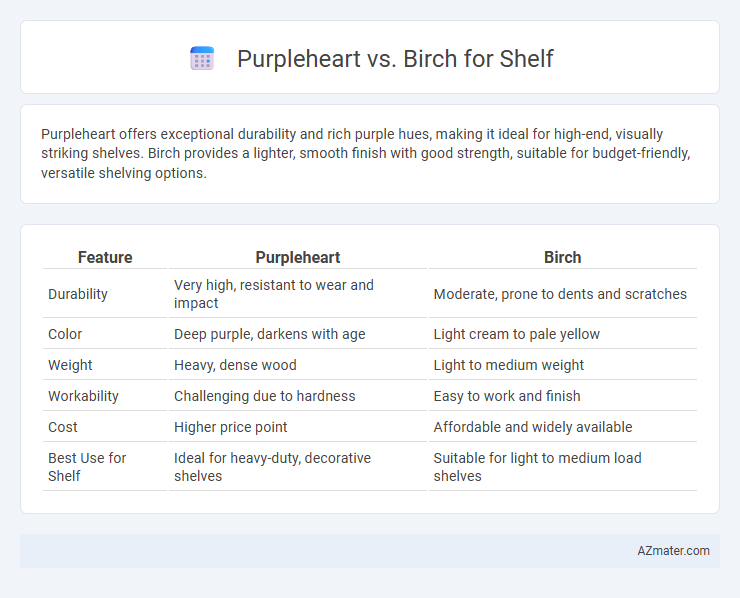Purpleheart offers exceptional durability and rich purple hues, making it ideal for high-end, visually striking shelves. Birch provides a lighter, smooth finish with good strength, suitable for budget-friendly, versatile shelving options.
Table of Comparison
| Feature | Purpleheart | Birch |
|---|---|---|
| Durability | Very high, resistant to wear and impact | Moderate, prone to dents and scratches |
| Color | Deep purple, darkens with age | Light cream to pale yellow |
| Weight | Heavy, dense wood | Light to medium weight |
| Workability | Challenging due to hardness | Easy to work and finish |
| Cost | Higher price point | Affordable and widely available |
| Best Use for Shelf | Ideal for heavy-duty, decorative shelves | Suitable for light to medium load shelves |
Introduction to Purpleheart and Birch Wood
Purpleheart wood, derived from several species of the Peltogyne genus native to Central and South America, is prized for its distinctive deep purple hue that darkens over time. Birch wood, primarily sourced from Betula species common in North America and Europe, offers a light, creamy color with a smooth grain that provides a subtle yet elegant appearance. Both woods are durable and dense, making them suitable for shelving, with Purpleheart known for its exceptional hardness and Birch favored for its workability and consistent texture.
Physical Characteristics: Purpleheart vs Birch
Purpleheart wood exhibits a dense, heavy structure with a distinctive deep purple hue that darkens over time, offering exceptional hardness and resistance to wear, making it ideal for durable shelving. Birch features a lighter, creamy color with a fine, even grain and a moderately hard but more lightweight composition, allowing for easier handling and a smooth finish. Both woods provide strong shelf support, but Purpleheart's superior density ensures higher load-bearing capacity and longevity compared to Birch.
Strength and Durability Comparison
Purpleheart offers exceptional strength with a Janka hardness of 2,520, making it highly resistant to dents and scratches, while birch has a softer Janka rating of around 1,260. The dense grain structure of purpleheart provides superior durability, ideal for heavy-duty shelving that endures significant weight and wear. Birch, though less hard, offers good shock resistance and stability, making it suitable for lighter use and affordable, sturdy shelving solutions.
Workability and Ease of Use
Purpleheart offers moderate workability with a fine, straight grain but requires sharp tools due to its density and natural oils, which can dull blades quickly. Birch is highly workable, featuring a uniform texture and pale color that sands and finishes smoothly, making it easier for precise cuts and shaping. For shelf construction, birch proves more user-friendly for beginners and those prioritizing ease of use, while purpleheart provides superior durability with more effort during machining.
Appearance and Aesthetics in Shelf Design
Purpleheart exhibits a rich, vibrant purple hue that intensifies over time, creating a striking and exotic appearance for shelf design. Birch offers a light, creamy color with subtle grain patterns, providing a clean and modern aesthetic suitable for minimalist interiors. The dense, fine grain of Purpleheart lends a smooth texture that contrasts with the uniform, slightly wavy grain of Birch, influencing the overall visual and tactile appeal of the shelf.
Cost and Availability Analysis
Purpleheart wood, known for its rich purple hue and durability, typically costs significantly more than birch due to its exotic origin and limited supply. Birch is more widely available across North America, making it an affordable and accessible option for shelves with consistent quality. The cost difference often leads builders to choose birch for budget-friendly projects, while purpleheart is favored for premium, visually striking shelving despite its higher price and more complex sourcing.
Environmental Impact and Sustainability
Purpleheart wood, harvested from tropical rainforests, poses higher environmental concerns due to potential deforestation and slower growth rates, making sustainability efforts critical for preserving biodiversity. Birch, commonly sourced from temperate forests with more managed and renewable forestry practices, generally offers a more sustainable option with a reduced ecological footprint. Choosing birch over purpleheart can help minimize environmental impact by supporting responsible forest management and faster wood regeneration cycles.
Weight and Load-Bearing Capacity
Purpleheart wood is significantly denser, with a weight of approximately 69 lbs per cubic foot, compared to birch, which weighs around 40-45 lbs per cubic foot, making Purpleheart sturdier for heavy-duty shelving. Its high density contributes to superior load-bearing capacity, allowing Purpleheart shelves to support more weight without bending or warping under pressure. Birch offers adequate strength for moderate loads but may require thicker boards or additional supports to match the durability provided by Purpleheart in weight-bearing applications.
Finishing and Maintenance Requirements
Purpleheart wood features a dense, oily grain that naturally resists moisture and decay, requiring minimal finishing beyond a clear coat to preserve its vibrant purple hue and protect against UV fading. Birch, with its lighter, softer texture, demands careful sealing and frequent maintenance using stains or varnishes to prevent yellowing and moisture damage on shelves. Purpleheart's inherent durability reduces upkeep, while birch shelves benefit from routine refinishing to maintain appearance and structural integrity.
Which is Better for Shelving: Purpleheart or Birch?
Purpleheart wood is exceptionally dense and durable, making it highly resistant to wear and ideal for heavy-duty shelving that supports significant weight. Birch, while lighter and easier to work with, offers a smooth finish and moderate strength suitable for decorative or light-to-medium load shelves. For superior longevity and strength in shelving, Purpleheart outperforms Birch, but Birch is often preferred where ease of machining and cost-effectiveness are priorities.

Infographic: Purpleheart vs Birch for Shelf
 azmater.com
azmater.com